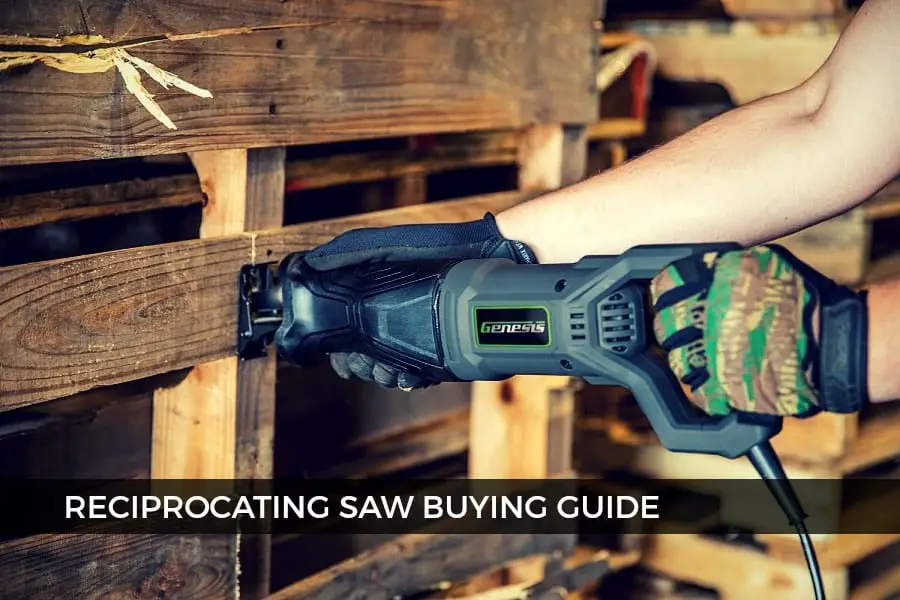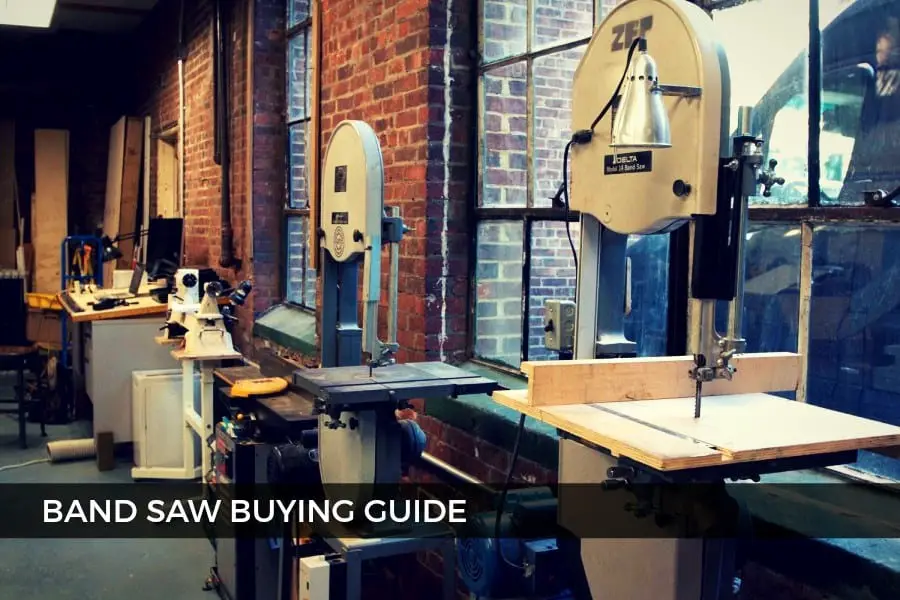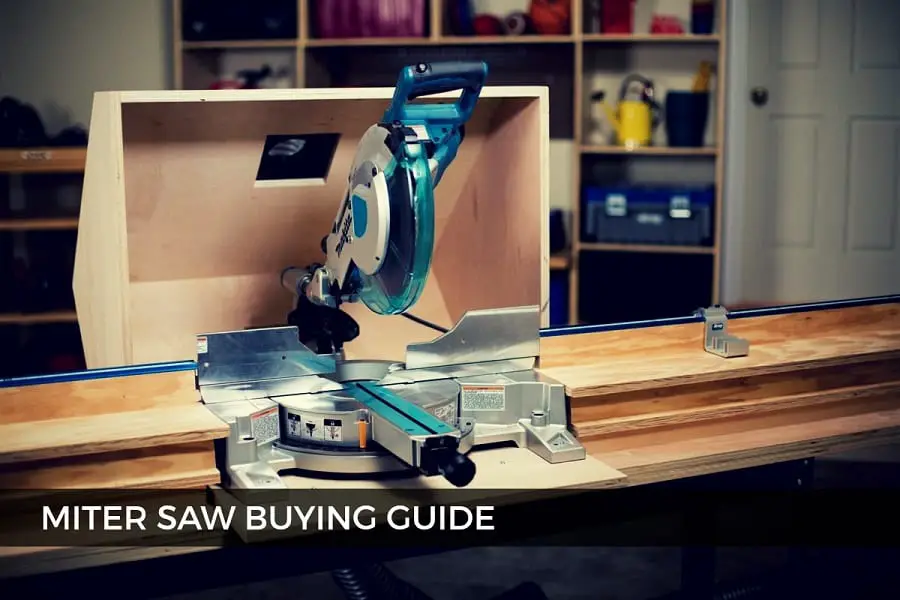Reciprocating saws are a bit on the shrewd side when compared to other types of saws, but if you plan on doing any demolitions, renovations, simple yard work and landscaping, or just need a versatile saw that can do pretty much anything, they are essential.
These types of saws are not entirely complicated, so the smallest of details and design can make a big difference as to how one performs when compared to another.
With all the choices out there, it can be difficult deciding on the best reciprocating saw for your own needs.
If you are having a hard time trying to figure out what you need from a reciprocating saw, or simply don’t know where to start, allow us to help.
Learn more about these great tools and find out which one is our top choice!
Best Reciprocating Saws Reviews & Recommendations For 2020
We’ve selected and tested a number of the saws on the market, which we’ve since sorted into two different price ranges, spelling out why we’ve chosen each one to include in our list for the best reciprocating saws for 2020.
We know that it is start of the year but you should acquire new tools for your next woodworking project.
Whether you’re an experienced contractor looking for your next couple of reciprocating saws, or a home DIY hobbyist who is looking to add one to their workshop, we’ve got you covered. There’s something here for everyone.
Best overall - Bosch CRS180K
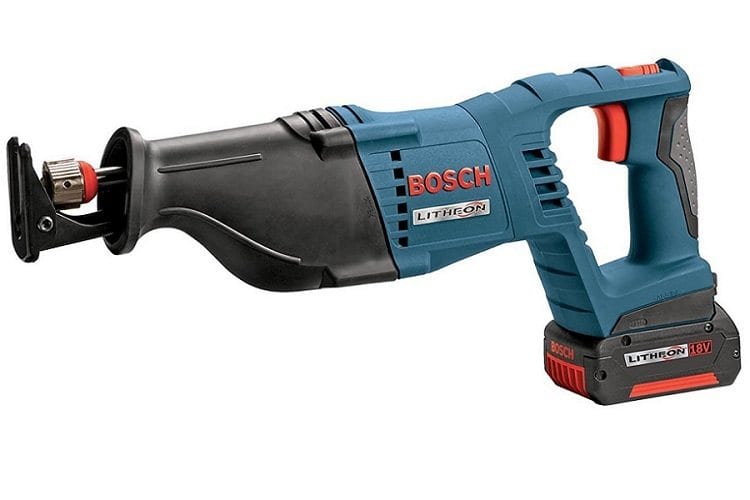
- Variable Speed: Yes
- Amperage: 11 amp
- Variable Speed Trigger: Yes
- Blade Clamp: Yes
The Bosch CRS180K offers an incredible value, combining low weight, a high amount of power, and plenty of versatility that allows it to handle a wide range of tasks with zero hesitation. Its capability and fair price make it an easy choice for our top choice.
The CRS180K is a heavy duty cordless model, but it avoids the lack of power and longevity that plagues many other models in that classification. It runs off of an 18-volt Litheon battery pack, which can be quickly charged, and holds a solid amount of power for extended periods of use.
The blade on the CRS180K has an impressive stroke of a 1 and ⅛ inches, giving you enough reach to cut through 4-inch pipes, 3-inch tree limbs, and other basic cutting tasks without any problems. You can even switch between two variable speeds: 2,400 and 2,700 strokes per minute.
The variable speed trigger of this reciprocating saw lets you choose between the two speeds by how hard you apply pressure. There’s no annoying secondary safety button to hold down either; just a switch instead.
There are also two blades included with the CRS180K, so you can get started immediately as soon as you open the box. The backup blade is a nice bonus that gives you some extended cutting life without the need to run out and purchase a backup blade.
Despite the power of the CRS180K, Bosch crams all of this into a body size that is only 17.4 inches long and weighs only 7.6 lbs. This makes it easy to use for long periods and gives you some added mobility and positioning when cutting at less than ideal angles when they come up.
Some additional features of the CRS180K include a Lock-Jaw blade holder that lets you quickly change out blades without any delay or hassle, helping make the saw a workhorse for contractors that encounter different materials that require different blades in one job.
The Bosch CRS180L truly offers you all you need from a simple and affordable reciprocating saw.
Its lightweight and easy handling are the perfect compliments to its power and easy blade changes which makes it a top selection in this category of saws.
For just under $300, this is the obvious choice for both serious DIY home hobbyists and professionals.
All this makes this great piece of tool, a best overall in the reciprocating saw segment of the market.
I did use this heavy duty saw for all of my woodworking projects. Even if it is a cordless model it is far better than lot of other corded reciprocating models out there.
This is one powerful saw.
Runner-Up - Milwaukee 2720-21
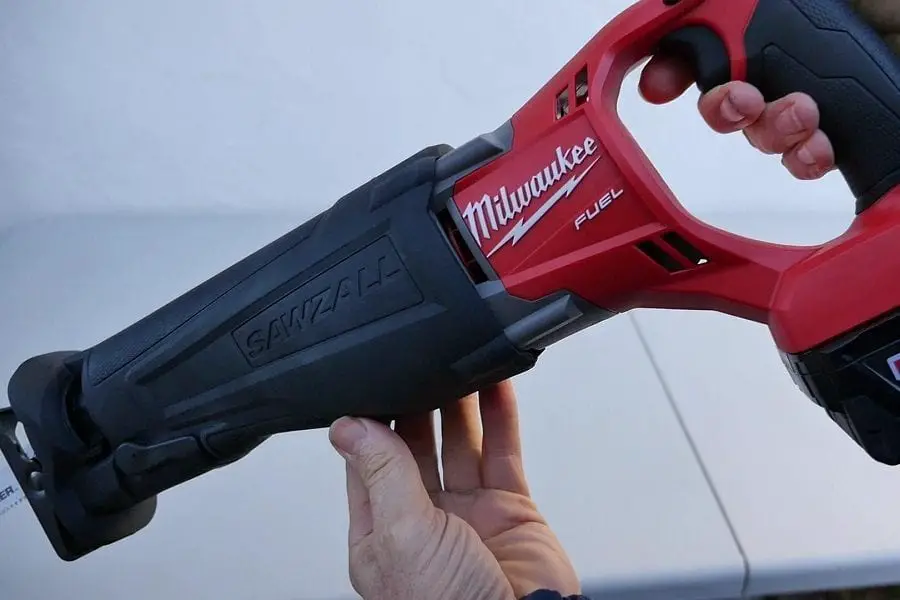
- Variable Speed: No
- Amperage: 11 amp
- Variable Speed Trigger: No
- Blade Clamp: Yes
The Milwaukee 2720-21 is geared towards contractors and home hobbyists that need a substantial amount of power in a cordless package, giving them more mobility on the job, without sacrificing cutting capability.
The 2720-21 runs on 18 volts of power off of a battery pack, which can be quickly recharged with the included battery docking station.
As for the REDLITHIUM XC 4.0 Extended Capacity Battery Pack, it has a runtime nearly double the average battery pack, giving users an added amount of performance and convenience.
One of the biggest advantages of the 2720-21 is its brushless 11 amp motor.
This setup gives it constant power for faster and more seamless cutting while reducing operating heat, giving the saw extended durability and longevity in all conditions.
The stroke length hovers around the standard 1-⅛” size, which is more than enough for any conventional recip saw task. A blade is included with the saw, which can operate anywhere from 0-3,000 strokes per minutes, depending on how hard you pull the trigger.
This variable speed setting will provide you with a lot of freedom when cutting different materials.
Although the 2720-21 is rather powerful, this doesn’t come at the expense of its compact size.
Dimensions measures 17 ¾” in length, and manages to keep the weight to 7.4 lbs. An ergonomic handle makes it easier to hold during extended use.
A unique trait of the 2720-21 is its REDLINK PLUS intelligence system, which ensures optimized performance, with protection from overloading, overheating and over-discharging.
Very useful for avoiding some of the common issues found with many other reciprocating saws.
Some added features of the saw include an adjustable shoe for different cutting angles and depths, an integrated LED light for better vision while cutting, a hook for hanging in your workshop, and a hard carrying case that fully protects the saw when transporting or storing which is not case in some of other reviewed reciprocating saws.
Overall, the 2720-21 is perfect for contractors who need a reciprocating saw with variable speed settings that can stand up to frequent, heavy use in all sorts of conditions, or the home DIY enthusiast that would prefer a more mobile reciprocating saws that still offers a top level of performance.
With its price in the med segment of the market, it for sure provides best value over other saws.
Alternative - Makita XRJ05Z
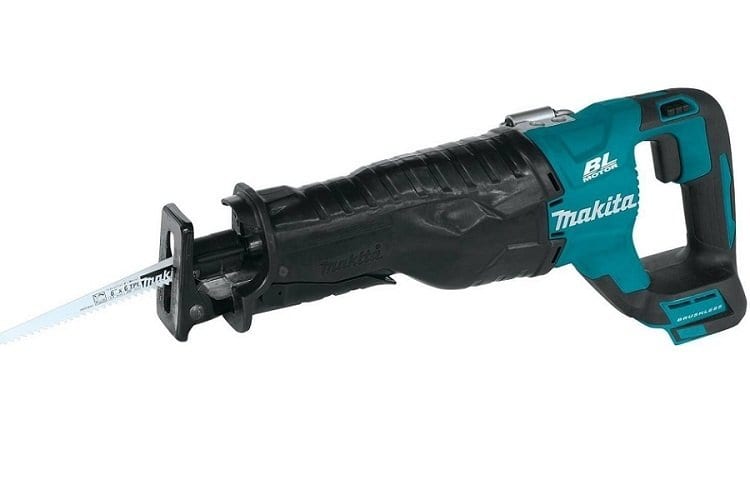
- Variable Speed: Yes
- Amperage: 11 amp
- Variable Speed Trigger: Yes
- Blade Clamp: No
Makita’s XRJ05Z is a professional reciprocating saw that places emphasis on smooth cutting operation, longer battery life, and extended cutting ability, all combining to equip it for the toughest jobs, both on and off the worksite.
Worth mentioning is that this is not a heavy duty tool.
As far as power goes, the XRJ05Z offers 18 volts via lithium-ion batteries. The battery pack is easily the industry’s fastest charging, allowing demanding users to get back to the worksite in a short matter of time between charges. The packs are compatible with all Makita LXT power tools. 11 amp motor is more than enough for every hobby craftsman out there.
The blade of the XRJ05Z offers a bit of extra reach, with a 1-¼” stroke that lets it handle pipes up to 10” in diameter. There are two variable speed settings for the blade, 2,300 and 3,000 maximum strokes per minutes. Speed control can be adjusted depending on the pressure of the trigger.
The XRJ05Z has an average size, but that’s a good thing considering its power and cutting length. Overall, the saw measures 17-¼”, and weighs just a bit over 8 lbs when the battery pack is attached. A rubberized soft grip handle makes it easy and comfortable to hold for long periods, with full control.
Many features and inclusions contribute to the way the XRJ05Z operates. One of the most notable examples is a refined crank mechanism design that helps to minimize blade deflection, while also reducing vibration effectively.
The XRJ05Z also features Star Protection, which is a communication technology that lets the saw and battery exchange data in real time, monitoring conditions during use to protect against overloading, over-discharging and overheating.
It though lacks blade clamp so it is one of rare downsides of this tool.
Other convenience features include an LED light to illuminate the cut line, a retractable tool hook for hanging, and “tool-less” blade change for faster blade installation and removal. A battery, charger and storage bag comes with the XRJ05Z as well.
The Makita XRJ05Z is very popular among contractors for a reason.
With its fair price, innovative technology, convenience, and extended usage capabilities, this saw make a very fine choice for anyone looking for an elite reciprocating saws.
Best Reciprocating Saws For The Money - DEWALT DC385B
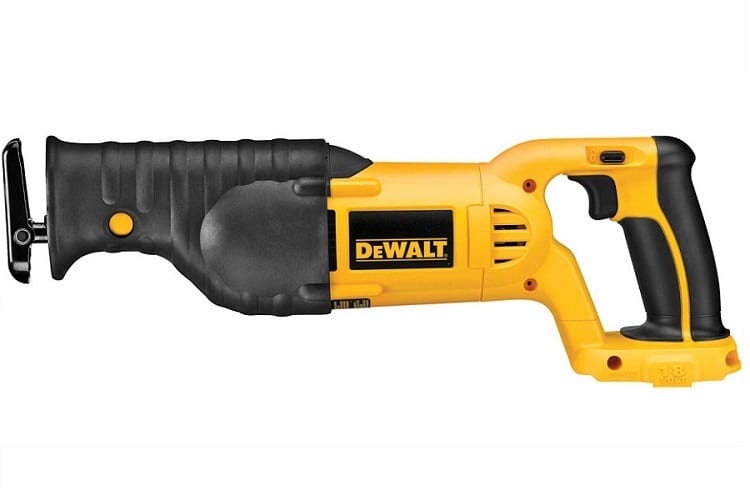
- Variable Speed: Yes
- Amperage: 11 amp
- Variable Speed Trigger: Yes
- Blade Clamp: Yes
DEWALT Bare-Tool DC385B is the ideal heavy duty reciprocating saw for those who are looking for a high amount of saw performance and capability, but for an extremely affordable price.
And while the “bare tool” part refers to the fact that the saw lacks a battery or blade, it’s still the best value around.
Like most reciprocating saws in this price range, the DC385B is intended for contractors, that have compatible battery packs and blades, and would rather just have the tool itself in its most stripped-down form.
This saves money and adds a more custom setup from the outset.
There are some blades available from numerous brands that will work this saw, and the same goes for DEWALT’s power tool battery packs.
The DC385B runs off of 18 volts, (powerful 12 amp motor) with the actual runtime dependent on your choice of the battery pack. With the appropriate battery installed, the saw offers a surprising amount of power and versatility, providing the same abilities you’ll find with many saws two or three times its price.
The saw gives users the standard 1-⅛” cutting stroke length, which should more than enough to do the job at the majority of worksites.
The DC385B offers anywhere from 0-3,000 RPM cutting speed, controlled by the pressure applied to the trigger.
As mentioned before this variable speed setting will assure that you have freedom when cutting different kind of materials and with speed control you can do almost any cut.
While there are no blades included with the DC385B, a lever-action keyless blade clamp gives users quick and easy blade changes in as little as 5 seconds. The clamp has four different positions, allowing for flushed cutting and more versatility.
The DC385B is a very light 5.8 lbs and includes an anti-slip comfort grip that provides increased comfort and control; along with a pivoting adjustable shoe with open top for optimal visibility.
It’s hard to ask for more from the DEWALT DC385B. Despite its smaller size and lack of fancy features, it offers one of the most controlled and efficient cutting actions you’ll find, ensures fast blade changes, and has just enough adjustability to give it more capability for a variety of jobs.
It for sure gets our best value award.
Runner-Up - Porter Cable PCC670B
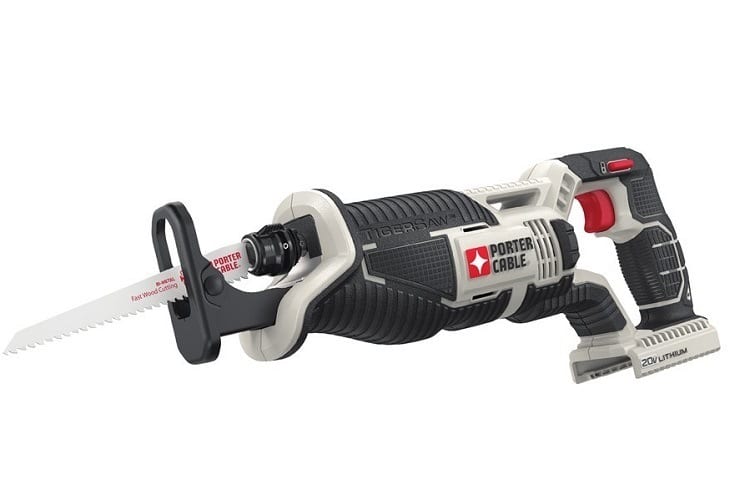
- Variable Speed: Yes
- Amperage: 12 amp
- Variable Speed Trigger: Yes
Porter Cable is well known for putting out incredibly solid power tools for a very affordable price, regardless of what kind it is.
The Porter Cable PCC670B is just another example of their ability to offers as much as they can for a price range that would usually indicate something much lower in quality.
The PCC670B does cut a few corners to keep the price down, but as long as you are using it for basic tasks, there won’t be a problem.
The PCC670B runs off of a 20-volt battery, which can quickly be recharged in between uses. The lack of a cord gives it more mobility than other recip saws in the same price range, without sacrificing any power.
The stroke length of the PCC670B hovers around one full inch, which is just a slight bit less than the average 1-⅛” stroke length. Again, as long as you aren’t trying to cut down 100 wall studs in 10 minutes, you should be just fine.
A trigger control offers variable speeds dependent on pressure, and you can go as high as 3,000 strokes per minutes, just like most of the bigger, more expensive saws. When it’s time to change blades, a tool-free blade release uses a quick twist-lock method that lets you swap one out in just a few seconds.
The PCC670B has an overall length of 14.5 inches, which is perfect for when you need to make cuts in cramped work areas where larger recip saws may encounter some issues.
The saw is very light as well, coming in at just 3.75 lbs. A contoured over-molded handle ensures a firm, comfortable grip with minimal vibration.
As expected, this saw is short on additional features, but the PCC670B does come with a pivoting adjustable shoe that lets users keep constant contact with the cutting material without straining.
This compliments the saw’s stable feel and low level of vibration, resulting in better accuracy and less strain.
It’s hard to believe that you can have a recip saw of this quality for such a low price, but that’s exactly what the Porter Cable PCC670B provides.
For well under $100, you get a solid, no-frills saw that can easily handle everything from trimming a pipe, to cutting down that ugly shrub in the backyard.
Ryobi Ryobi Reciprocating Saw
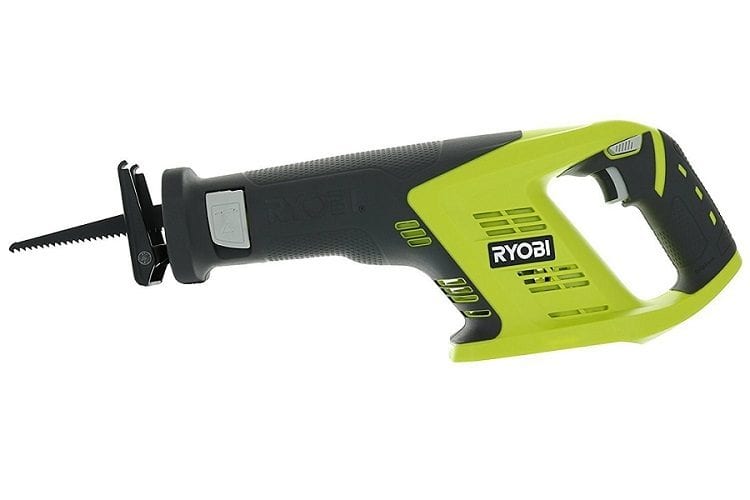
- Variable Speed: No
- Amperage: 12 amp
- Variable Speed Trigger: No
Ryobi is a widely recognized name in power tools, especially in the world of saws.
The P515 is part of a long line of recip saws from the company and targeted to those who already have a power pack that is compatible with the saw, and don’t mind buying their blades as well.
This allows the P515 to have one of the lowest prices on this list, despite all it offers once it’s fully set up and ready to go.
For those interested, the P515 is part of the One+ series, meaning it works with different types of Ryobi 18V batteries, such as the P100, P101, P102, P103, P104, P105, P107, and P108 — all of which can be found on Amazon.
As you probably noticed, the 18 volt P515 is completely cordless and fully mobile, with an overall runtime that depends on the battery pack that you go with. No worrying about having to drag an extension cord around with you as you use the saw.
The P515 offers a blade stroke length of 1-⅛”, which is the same you’ll usually encounter, and more than enough for basic tasks that this saw is appropriate for.
It has a little higher of a blade speed as well — 3,100 strokes per minutes to be exact. This gives you a little extra power for tougher materials.
The body of the P515 is one of the smallest in its class, giving you a bit more flexibility when trying to navigate the saw in close quarters when you lack in space for maneuvering.
And with a weight of 4.35 lbs, the P515 is light enough to hold for long periods with no strain.
Some standout features of the P515 include a rubber overmold for better grip and control, an anti-vibration handle that gives you better accuracy and less strain, and a quick blade change system that allows for quick blade changes in just a matter of seconds.
If you’re looking to keep things under the $50 range, and already have a Ryobi One+ battery pack (or plan on getting one to use with other tools,) the Ryobi P515 is an excellent option that can help you streamline your tool collection, without overspending or compromising on power and quality.
Why You Should Choose Your Reciprocating Saw Carefully?
As we’ve already mentioned, reciprocating saws are not very complicated, but they offer plenty of variance regarding sizes, power, features, and overall capabilities. Like with any power tool, it’s crucial that you get the appropriate tool for the job.
If you purchase an inadequate saw for what you’re needing, you are going to end up with lackluster results when using it, and may even put yourself in danger in some scenarios.
Likewise, if you have very minimal needs for your saw, yet you rush out and purchase a professional-level saw that could easily cut your entire house in half, you probably wasted your money, and may even have more power than needed for your required tasks.
So, with reciprocating saws, there are a lot of aspects you’ll need to be mindful of before purchasing to make sure you end up with the right one.
We’ll start by talking about the different types, what they are best for, and all of the factors and specs you can examine before buying.
Types Of Reciprocating Saws And Their Uses
As far as reciprocating saws go, there aren’t all that many types.
All of these saws have a similar build and main design, which is a drill-like power body, and a hacksaw-like blade that protrudes from the front that saws back and forth in a rapid fashion when a trigger is squeezed.
Still, there are a few ways to classify these.
Cordless/Battery Operated reciprocating saw
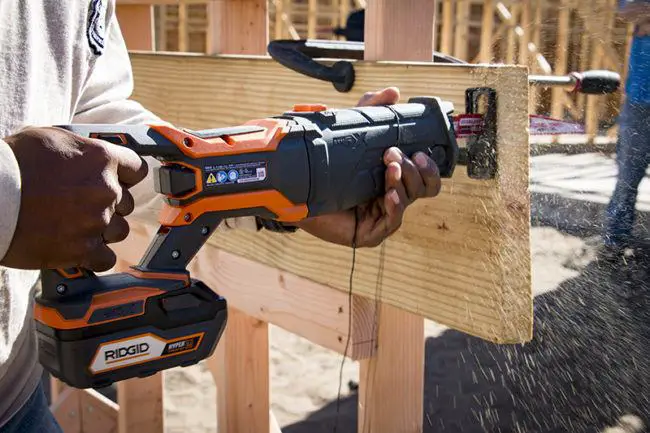
By far the most convenient, cordless reciprocating saws run off of a battery pack, which is usually lithium and is the same battery type you’ll find with other power tools.
In fact, depending on the brand, you may be able to use the battery in other tools as well.
Battery powered reciprocating saws often come in 9, 12, 18, and 20-volt sizes. The brand and quality of the saw’s battery pack will determine just how long it can go in between charges, and how fast it can charge once it’s depleted.
While cordless reciprocating saws offer convenience for practically anyone in any scenario, they are especially helpful for those that need to bring them on a job site that either doesn’t have power or is far away from any electrical outlets.
This most commonly includes construction sites in the early phases (often during framing as you can see at photo above,) and use for landscaping, such as sawing tree limbs.
Those working in crawl spaces, or around plumbing in tight scenarios can appreciate cordless models as well.
Corded reciprocating saw
Like the name says, these are any reciprocating saws that you have to plug into a power source. While this is not as convenient as a cordless model, plenty of users won’t have any issues with regards to convenience.
If you plan on using your saw around the yard nearby your home, inside your workshop, or inside your home, while you have access to outlets, corded models can be perfectly fine.
They also offer a few advantages in some scenarios as well. For one thing, they are often cheaper than cordless models and usually have little more power for the money too.
Another plus with these is that fact that you don’t have to worry about your battery running out of power, or having to recharge and wait in the meantime.
Corded reciprocating saws are dwindling in numbers on the market, but they are usually a solid choice for home users who have lighter reciprocating saw tasks, or always have outlet access and don’t mind dealing with extension cords.
Sometimes it’s just a preference thing.
Mini Reciprocating Saw - Size Doesn't Matter
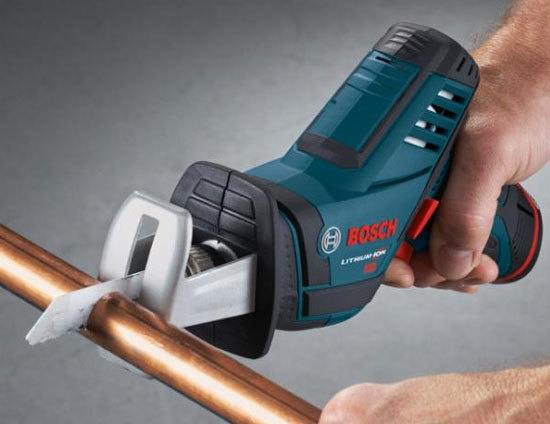
One of the drawbacks to a reciprocating saw is its shape. While it may not matter when you’re cutting off a wall stud, extra wood sticking out, or framing on a window, if you are working with HVAC or plumbing, you may not have that much space to operate.
For this reason, you can find some smaller reciprocating saws that make it easier when working in tight scenarios. These are usually cordless to make them even more convenient. Mini reciprocating saws are too small for some tasks, however.
Things To Consider When Choosing Your Reciprocating Saw
Reciprocating saws have many specifications and features that almost always reflect what they are capable of, how easy they are to use, and how long they can be used.
Here are the main things to examine in relation to what your reciprocating saw needs are.
Blade Speed of the tool
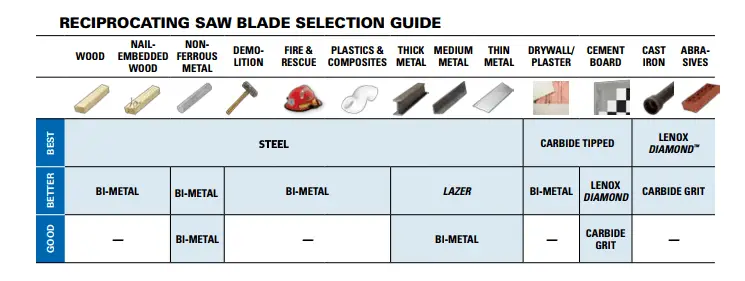
The speed of the blade when cutting is one the primary specs you need to give attention to, as it indicates what the saw is capable of in many ways.
Reciprocating saw speed is measured by SPM, which is strokes per minute. When the saw blade moves forward and back in a quick motion, this is one stroke. The faster the SPM, the faster the blade goes back and forth like a hacksaw (also known as reciprocating, in case you’re wondering where the name comes from).
As you can probably guess, you should aim for saws with variable speed settings.
Most reciprocating saws can offer at least 2,700 SPM, with some lower quality models starting at 2,500 SPM.
A reciprocating saw that can go to 3,000 SPM and above it a good sign, and means that it can easily cut more than just particle boards with ease.
Some reciprocating saws will have two different max variable speed settings, letting you pull down fully on the trigger, with a preset maximum SPM. This is good for when you are sawing items like metal pipes, when you may want the SPM to be lower because of heat generated.
But remember, it is difficult to do proper metal cutting with any reciprocating saw.
SAW Weight
The weight of a reciprocating saw can sometimes get overlooked. If you plan on using the saw for long periods or need one that can be very accurate in highly precise situations, the weight becomes a huge factor.
While reciprocating saw weight ranges are all over the place, it’s best to try and keep things under 9 lbs when using larger models, and under 5 lbs when using smaller models with less power overall.
Overly heavy reciprocating saws can tire you out quickly and are harder to be more precise with.
Blade Stroke - very important feature to consider
The stroke of the blade refers to how far it moves back and forth when sawing. The longer the stroke, the smoother the cut will be, while also being easier.
The vast majority of reciprocating saws usually have a decent blade stroke, but you’ll want to make sure it’s at least 1-inch minimum.
1-⅛” is the most common blade stroke size, with some larger models reaching 1-¼” or even 1-½”.
Power Source - Should You Opt For Portable One
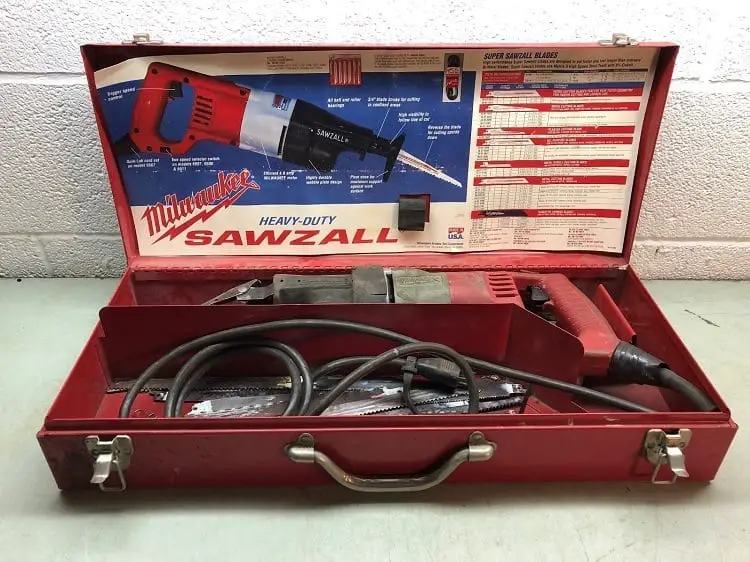
We’ve been through this already, but it’s worth mentioning again.
The saw’s power source plays a big role in its mobility and overall versatility, so if you’re planning on using the saw at construction sites, or far away from your home or work area, make sure you go with cordless.
Extra Features - what more?
Reciprocating saws do offer some extra features among various models that can do everything from making the operation smoother and easier to handle to making blade switches better, to even including blades in the first place.
Blade Changing Method
With most saws, you often have to use some sort of key or tool to loosen the blade so you can switch it out. This happens with some reciprocating saws as well.
Reciprocating saws have a wide range of blade types, so switching them out needs to be fast and seamless, preferably. Look for reciprocating saws that have quick blade changing methods that don’t require a special tool.
Blades And Batteries Included
Believe it or not, some reciprocating saws don’t come with blades. While most reciprocating saw blades aren’t all that expensive, some may want to purchase a saw that is fully ready to go from the outset.
The same goes for batteries if you’re going cordless. Always try to buy saws that come with batteries and at least beginner set of blades.
Some major brands offer some saws without batteries, mainly if you already use their compatible battery packs with other tools.
If you need a standalone reciprocating saw that is ready to use, make sure it comes with the blade and battery.
While not essential a good solid carrying case is always recommended for better storage and easier transport. A hard case is even better. Always go with a hard case if you have a choice.
Conclusion

Reciprocating saws are easily one of the most versatile and simple saws, and actually, pretty fun to use at times as well.
To reiterate what I said earlier. If you ever plan on doing any demolition, renovations, plumbing work, or landscaping involving a saw, a reciprocating saw is always up to the task, making it a true all-in-one saw in many ways.
Hopefully, you have a better idea on how to shop for one, and how to match your anticipated needs to a particular model. The six best reciprocating saws listed above all make valuable additions to your shop lineup, so happy shopping, and as always, thanks for reading.
Resources

